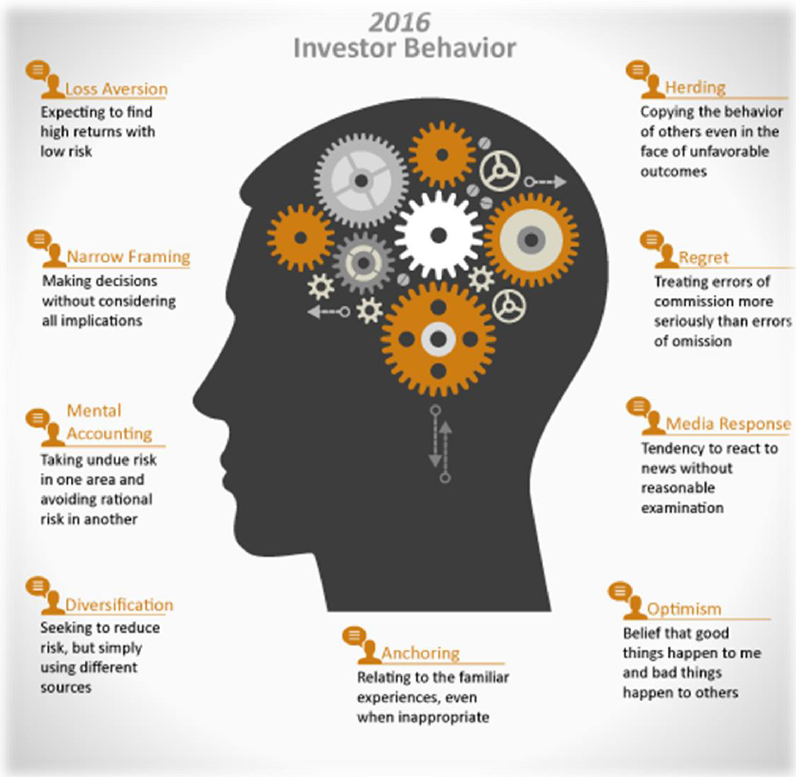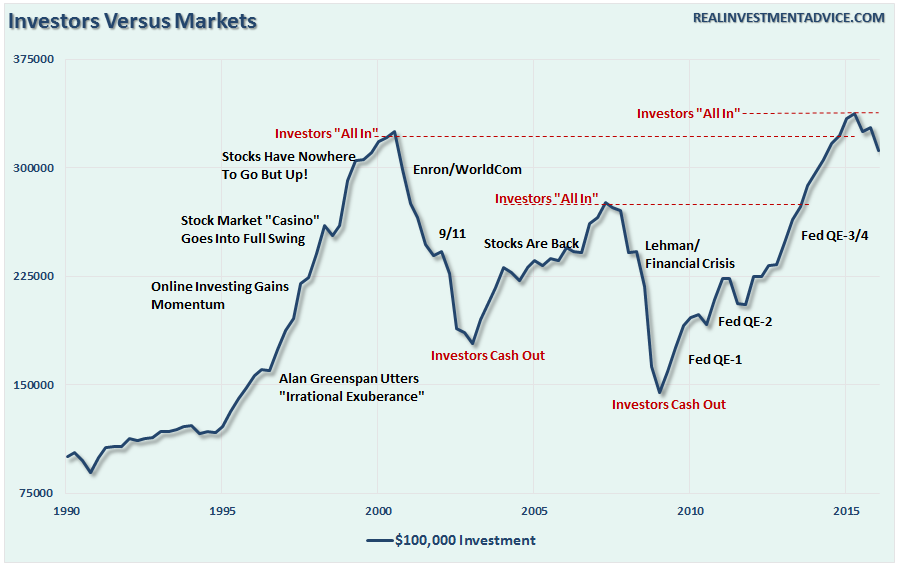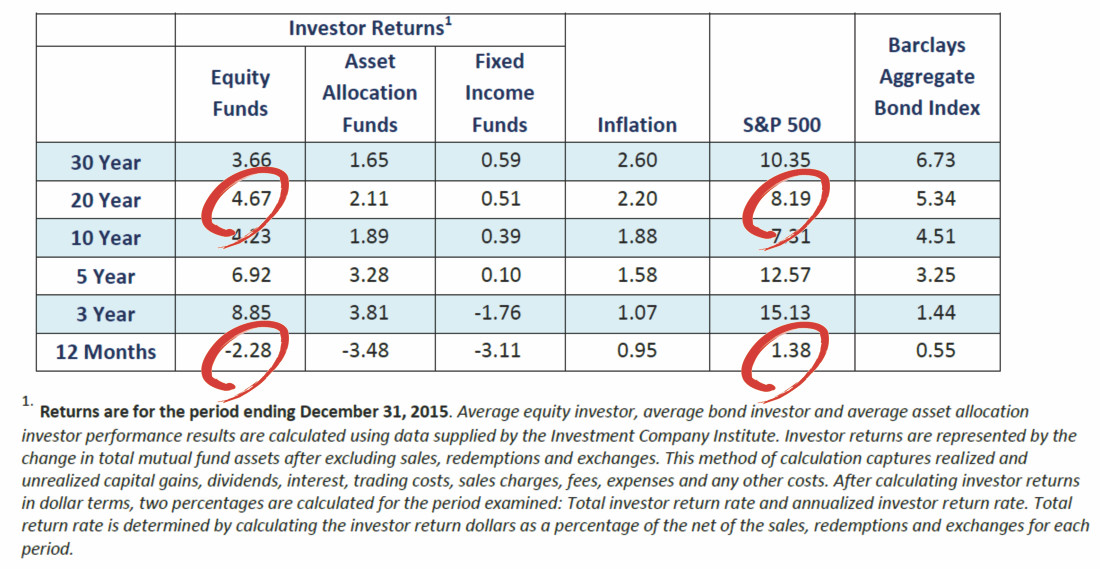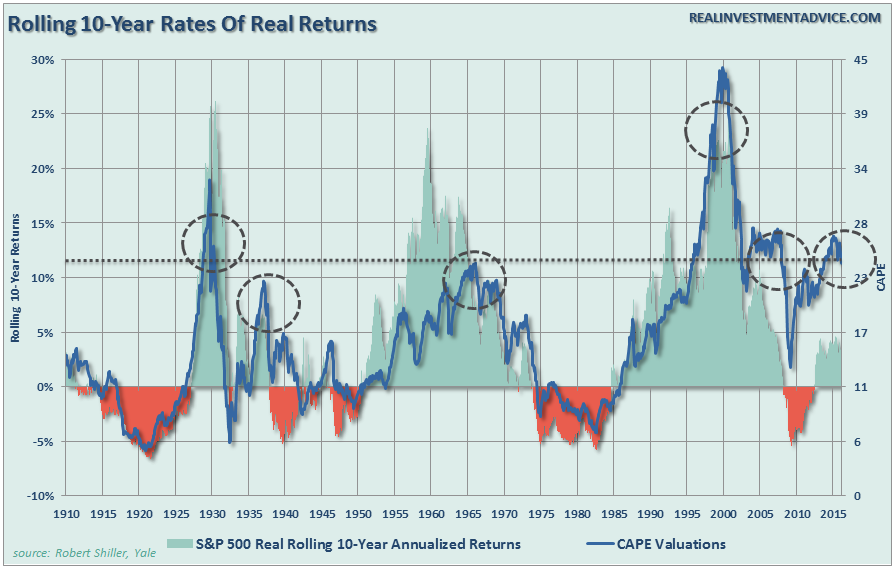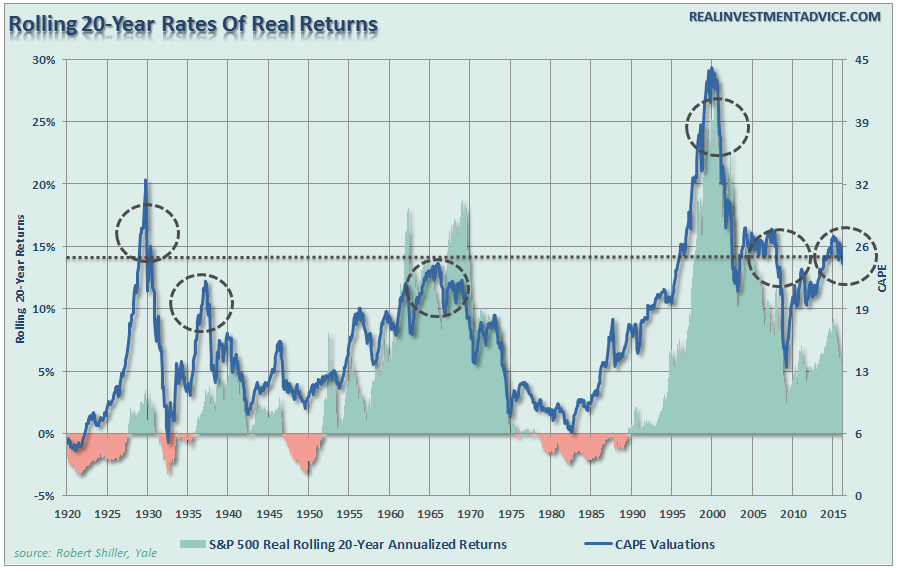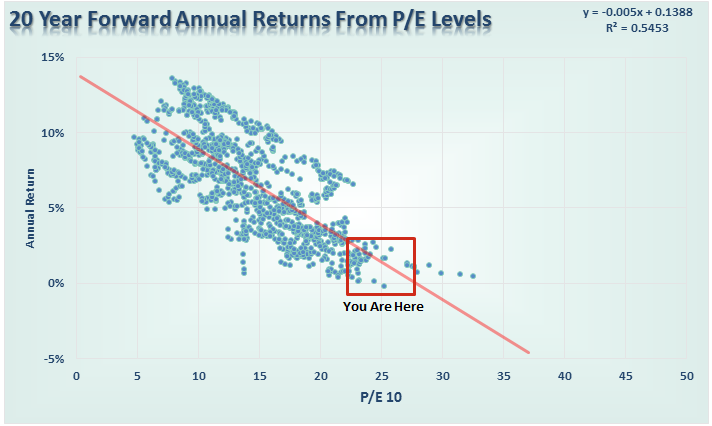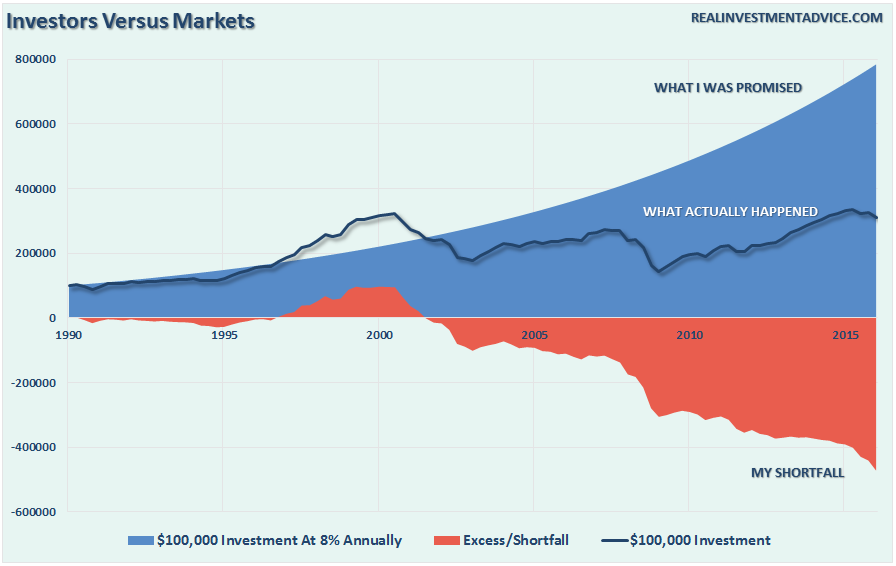This morning I received a “financial plan” from an individual wanting me to review it with respect to his personal retirement goals. The plan was generated by one of the many “off the shelf” software packages that takes all the inputs of income, assets, pensions, social security, etc., and then spits out assumptions of future asset values and drawdowns in retirement.
The problem is that the return assumptions were grossly flawed.
In all of these plans, it is assumed individuals will have a rate of return of somewhere between 5-10% annually heading into retirement, and then 4-8% thereafter. The first major flaw in the plan is the “compounding” of annual returns over time which never happens. The second, and most important, is the future expectation of returns for individuals over the next 10-20 years.
This second point is what I want to address today.
There are two main reasons why returns over the next decade, or two, are currently being overestimated. The first is a “you problem,” the second is “math”.
It’s A You Problem
Last week, I updated the Dalbar Study article which explains why investors consistently “suck” at investing. As I detailed in that article, one of the biggest impediments to achieving long-term investment returns is the impact of emotionally driven investment mistakes.
Investor psychology is helpful in understanding the specific thoughts and actions that lead to poor decision-making. That psychology not only drives the “buy high/sell low” syndrome, but also the traps, triggers, and misconceptions that lead to a variety of irrational mistakes that reduce returns over time.
There are 9 distinct behaviors that tend to plague investors based on their personal experiences and unique personalities.
As I stated last week:
“The biggest of these problems for individuals is the “herding effect” and “loss aversion.”
These two behaviors tend to function together compounding the issues of investor mistakes over time. As markets are rising, individuals are lead to believe that the current price trend will continue to last for an indefinite period. The longer the rising trend last, the more ingrained the belief becomes until the last of “holdouts” finally “buys in” as the financial markets evolve into a “euphoric state.”
As the markets decline, there is a slow realization that “this decline” is something more than a “buy the dip”opportunity. As losses mount, the anxiety of loss begins to mount until individuals seek to “avert further loss” by selling.
As shown in the chart below, this behavioral trend runs counter-intuitive to the “buy low/sell high” investment rule.”
“In the end, we are just human. Despite the best of our intentions, it is nearly impossible for an individual to be devoid of the emotional biases that inevitably lead to poor investment decision-making over time. This is why all great investors have strict investment disciplines that they follow to reduce the impact of human emotions.
More importantly, despite studies that show that “buy and hold,” and “passive indexing” strategies, do indeed work over very long periods of time; the reality is that few will ever survive the downturns in order to see the benefits.”
The impact of these emotionally driven mistakes leads to long-term under-performance below those “goal based” financial projections.
It’s Just Math
“But Lance, the markets has returned 10% on average over the last century, so I will probably be okay.”
True. If you can contract “vampirism,” avoid sunlight, garlic, and crosses, you can live long enough to achieve the “average annual rate of return” seen over the last 116 years.
For the rest of us mere mortals, and why “duration matching” is so crucially important, we only have between today and retirement to reach our goals. For the majority of us – that is about 15 years.
And therein lies the problem.
Despite much of the commentary which continues to suggest we are in a long-term secular bull market, the math suggests something substantially different. However, it is important to understand when low future rates of return are discussed, it is not meant that each year will be low but the return for the entire period will be low. The charts below show the 10 and 20-year rolling REAL, inflation-adjusted, returns for the markets as compared to trailing valuations. (Important note: Many advisors/analysts often pen that the market has never had a 10 or 20-year negative return. That is only on a nominal basis and should be disregarded as inflation must be included in the debate.)
There are two important points to take away from the data. First, is that there are several periods throughout history where market returns were not only low, but negative. Secondly, the periods of low returns follow periods of excessive market valuations. “This time is not different.”
As David Leonhardt noted previously:
“The classic 1934 textbook ‘Security Analysis’ – by Benjamin Graham, a mentor to Warren Buffett, and David Dodd – urged investors to compare stock prices to earnings over ‘not less than five years, preferably seven or ten years.’ Ten years is enough time for the economy to go in and out of recession. It’s enough time for faddish theories about new paradigms to come and go.”
History shows that valuations above 23x earnings have tended to denote secular bull market peaks. Conversely, valuations at 7x earnings, or less, have tended to denote secular bull market starting points.
This point can be proven simply by looking at the distribution of returns as compared to valuations over time.
From current levels history suggest that returns to investors over the next 10 and 20-years will likely be lower than higher. However, as I said, we can also prove this mathematically as well.
Capital gains from markets are primarily a function of market capitalization, nominal economic growth plus the dividend yield. Using John Hussman’s formula we can mathematically calculate returns over the next 10-year period as follows:
(1+nominal GDP growth)*(normal market cap to GDP ratio / actual market cap to GDP ratio)^(1/10)-1
Therefore, IF we assume that GDP could maintain 4% annualized growth in the future, with no recessions, AND IF current market cap/GDP stays flat at 1.25, AND IF the current dividend yield of roughly 2% remains, we get forward returns of:
(1.04)*(.8/1.25)^(1/10)-1+.02 = 1.5%
But there is a “whole lotta ifs” in that assumption. More importantly, if we assume that inflation remains stagnant at 2%, as the Fed hopes, this would mean a real rate of return of -0.5%.
In either case, these numbers are well below the majority of financial plan projections which will leave retirees well short of their expected retirement goals.
Conclusion
While the majority of analysis is based on the idea that individuals should “buy and hold” indexed based portfolios, reality has been far different.
With retirement plans having a finite time span for both accumulation and distribution of assets, the time lost in “getting back to even” following a major market correction is the primary consideration.
The chart below picks up on the investor psychology chart first shown above. The chart below illustrates the difference between expectations and reality. The illustration shows the difference between the inflation-adjusted return on a $100,000 investment in the S&P 500 growing at 8% annually as opposed to the impact of gains and losses in market returns over time. The reason the chart begins in 1990 is, despite analysis showing 116-year investment returns, roughly 80% of all investors today began investing. Of that 80%, roughly 80% of those began after 1995. If you don’t believe me, go ask 10 random people when they started investing in the financial markets and you will likely be surprised by what you find.
Unfortunately, most investors remain woefully behind their promised financial plans. Given current valuations, and the ongoing impact of “emotional decision making,” the outcome is not likely going to improve over the next decade or possibly two.
Markets are not cheap by any measure. If earnings growth continues to wane, interest rates rise, not to mention the impact of demographic trends, the bull market thesis will collapse as “expectations” collide with “reality.” This is not a dire prediction of doom and gloom, nor is it a “bearish” forecast. It is just a function of how the “math works over time.”
For investors, understanding potential returns from any given valuation point is crucial when considering putting their “savings” at risk. Risk is an important concept as it is a function of “loss”. The more risk that is taken within a portfolio, the greater the destruction of capital will be when reversions occur.
This time is “not different.” The only difference will be what triggers the next valuation reversion when it occurs. If the last two bear markets haven’t taught you this by now, I am not sure what will. Maybe the third time will be the “charm.”
Lance Roberts
Lance Roberts is a Chief Portfolio Strategist/Economist for Clarity Financial. He is also the host of “The Lance Roberts Show” and Chief Editor of the “Real Investment Advice” website and author of “Real Investment Daily” blog and “Real Investment Report“. Follow Lance on Facebook, Twitter, and Linked-In

